ADT 2009 Annual Report Download - page 224
Download and view the complete annual report
Please find page 224 of the 2009 ADT annual report below. You can navigate through the pages in the report by either clicking on the pages listed below, or by using the keyword search tool below to find specific information within the annual report.-
 1
1 -
 2
2 -
 3
3 -
 4
4 -
 5
5 -
 6
6 -
 7
7 -
 8
8 -
 9
9 -
 10
10 -
 11
11 -
 12
12 -
 13
13 -
 14
14 -
 15
15 -
 16
16 -
 17
17 -
 18
18 -
 19
19 -
 20
20 -
 21
21 -
 22
22 -
 23
23 -
 24
24 -
 25
25 -
 26
26 -
 27
27 -
 28
28 -
 29
29 -
 30
30 -
 31
31 -
 32
32 -
 33
33 -
 34
34 -
 35
35 -
 36
36 -
 37
37 -
 38
38 -
 39
39 -
 40
40 -
 41
41 -
 42
42 -
 43
43 -
 44
44 -
 45
45 -
 46
46 -
 47
47 -
 48
48 -
 49
49 -
 50
50 -
 51
51 -
 52
52 -
 53
53 -
 54
54 -
 55
55 -
 56
56 -
 57
57 -
 58
58 -
 59
59 -
 60
60 -
 61
61 -
 62
62 -
 63
63 -
 64
64 -
 65
65 -
 66
66 -
 67
67 -
 68
68 -
 69
69 -
 70
70 -
 71
71 -
 72
72 -
 73
73 -
 74
74 -
 75
75 -
 76
76 -
 77
77 -
 78
78 -
 79
79 -
 80
80 -
 81
81 -
 82
82 -
 83
83 -
 84
84 -
 85
85 -
 86
86 -
 87
87 -
 88
88 -
 89
89 -
 90
90 -
 91
91 -
 92
92 -
 93
93 -
 94
94 -
 95
95 -
 96
96 -
 97
97 -
 98
98 -
 99
99 -
 100
100 -
 101
101 -
 102
102 -
 103
103 -
 104
104 -
 105
105 -
 106
106 -
 107
107 -
 108
108 -
 109
109 -
 110
110 -
 111
111 -
 112
112 -
 113
113 -
 114
114 -
 115
115 -
 116
116 -
 117
117 -
 118
118 -
 119
119 -
 120
120 -
 121
121 -
 122
122 -
 123
123 -
 124
124 -
 125
125 -
 126
126 -
 127
127 -
 128
128 -
 129
129 -
 130
130 -
 131
131 -
 132
132 -
 133
133 -
 134
134 -
 135
135 -
 136
136 -
 137
137 -
 138
138 -
 139
139 -
 140
140 -
 141
141 -
 142
142 -
 143
143 -
 144
144 -
 145
145 -
 146
146 -
 147
147 -
 148
148 -
 149
149 -
 150
150 -
 151
151 -
 152
152 -
 153
153 -
 154
154 -
 155
155 -
 156
156 -
 157
157 -
 158
158 -
 159
159 -
 160
160 -
 161
161 -
 162
162 -
 163
163 -
 164
164 -
 165
165 -
 166
166 -
 167
167 -
 168
168 -
 169
169 -
 170
170 -
 171
171 -
 172
172 -
 173
173 -
 174
174 -
 175
175 -
 176
176 -
 177
177 -
 178
178 -
 179
179 -
 180
180 -
 181
181 -
 182
182 -
 183
183 -
 184
184 -
 185
185 -
 186
186 -
 187
187 -
 188
188 -
 189
189 -
 190
190 -
 191
191 -
 192
192 -
 193
193 -
 194
194 -
 195
195 -
 196
196 -
 197
197 -
 198
198 -
 199
199 -
 200
200 -
 201
201 -
 202
202 -
 203
203 -
 204
204 -
 205
205 -
 206
206 -
 207
207 -
 208
208 -
 209
209 -
 210
210 -
 211
211 -
 212
212 -
 213
213 -
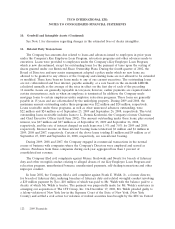 214
214 -
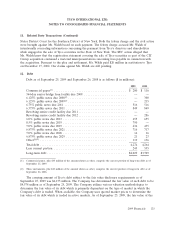 215
215 -
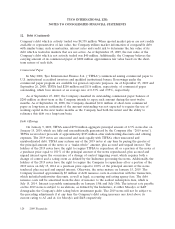 216
216 -
 217
217 -
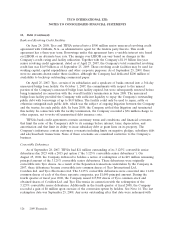 218
218 -
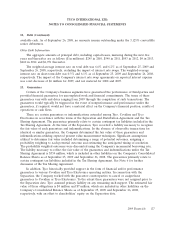 219
219 -
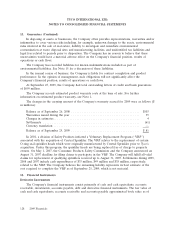 220
220 -
 221
221 -
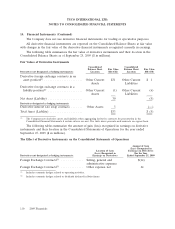 222
222 -
 223
223 -
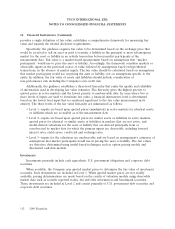 224
224 -
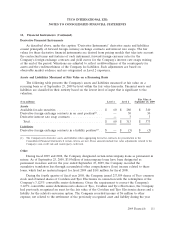 225
225 -
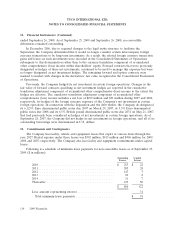 226
226 -
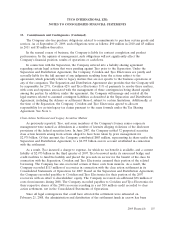 227
227 -
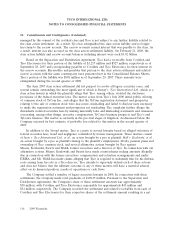 228
228 -
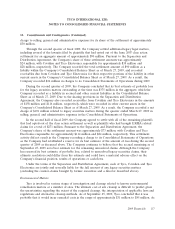 229
229 -
 230
230 -
 231
231 -
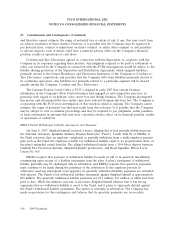 232
232 -
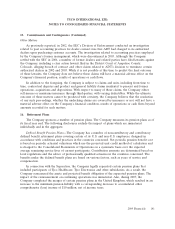 233
233 -
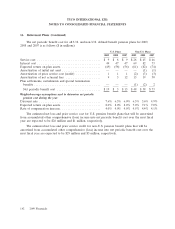 234
234 -
 235
235 -
 236
236 -
 237
237 -
 238
238 -
 239
239 -
 240
240 -
 241
241 -
 242
242 -
 243
243 -
 244
244 -
 245
245 -
 246
246 -
 247
247 -
 248
248 -
 249
249 -
 250
250 -
 251
251 -
 252
252 -
 253
253 -
 254
254 -
 255
255 -
 256
256 -
 257
257 -
 258
258 -
 259
259 -
 260
260 -
 261
261 -
 262
262 -
 263
263 -
 264
264 -
 265
265 -
 266
266 -
 267
267 -
 268
268 -
 269
269 -
 270
270 -
 271
271 -
 272
272 -
 273
273 -
 274
274 -
 275
275 -
 276
276 -
 277
277 -
 278
278 -
 279
279 -
 280
280 -
 281
281 -
 282
282 -
 283
283 -
 284
284 -
 285
285 -
 286
286 -
 287
287 -
 288
288 -
 289
289 -
 290
290
 |
 |
TYCO INTERNATIONAL LTD.
NOTES TO CONSOLIDATED FINANCIAL STATEMENTS
14. Financial Instruments (Continued)
provides a single definition of fair value, establishes a comprehensive framework for measuring fair
value and expands the related disclosure requirements.
Specifically, the guidance requires fair value to be determined based on the exchange price that
would be received to sell an asset or paid to transfer a liability in the principal or most advantageous
market for the asset or liability in an orderly transaction between market participants at the
measurement date. Fair value is a market-based measurement based on assumptions that ‘‘market
participants’’ would use to price the asset or liability. Accordingly, the framework considers markets or
observable inputs as the preferred source of value followed by assumptions based on hypothetical
transactions, in the absence of market inputs. The fair value should be calculated based on assumptions
that market participants would use in pricing the asset or liability, not on assumptions specific to the
entity. In addition, the fair value of assets and liabilities should include consideration of
non-performance risk including the Company’s own credit risk.
Additionally, the guidance establishes a three-level hierarchy that ranks the quality and reliability
of information used in developing fair value estimates. The hierarchy gives the highest priority to
quoted prices in active markets and the lowest priority to unobservable data. In cases where two or
more levels of inputs are used to determine fair value, a financial instrument’s level is determined
based on the lowest level input that is considered significant to the fair value measurement in its
entirety. The three levels of the fair value hierarchy are summarized as follows:
• Level 1—inputs are based upon quoted prices (unadjusted) in active markets for identical assets
or liabilities which are accessible as of the measurement date.
• Level 2—inputs are based upon quoted prices for similar assets or liabilities in active markets,
quoted prices for identical or similar assets or liabilities in markets that are not active, and
model-derived valuations for the asset or liability that are derived principally from or
corroborated by market data for which the primary inputs are observable, including forward
interest rates, yield curves, credit risk and exchange rates.
• Level 3—inputs for the valuations are unobservable and are based on management’s estimates of
assumptions that market participants would use in pricing the asset or liability. The fair values
are therefore determined using model-based techniques such as option pricing models and
discounted cash flow models.
Investments
Investments primarily include cash equivalents, U.S. government obligations and corporate debt
securities.
When available, the Company uses quoted market prices to determine the fair value of investment
securities. Such investments are included in Level 1. When quoted market prices are not readily
available, pricing determinations are made based on the results of valuation models using observable
market data such as recently reported trades, bid and offer information and benchmark securities.
These investments are included in Level 2 and consist primarily of U.S. government debt securities and
corporate debt securities.
132 2009 Financials
